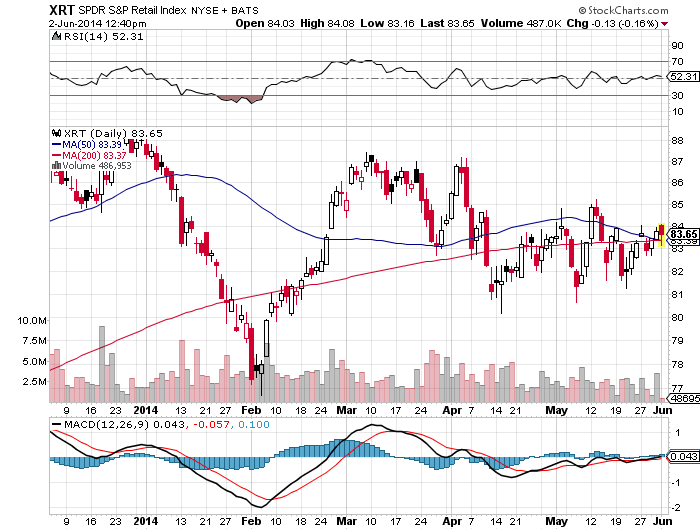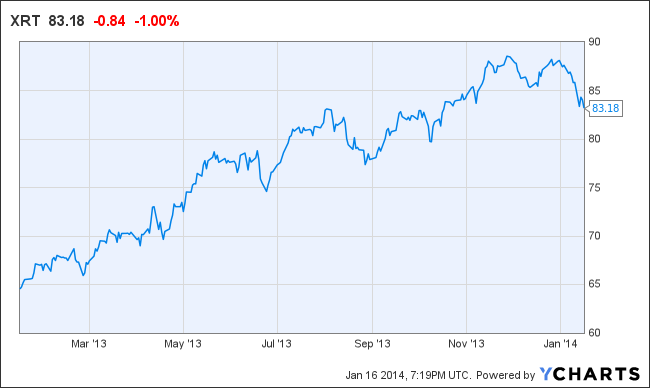ETF Outlook SPDR S P Retail ETF (XRT)
Post on: 11 Апрель, 2015 No Comment

XRT
Exchange Traded Funds or ETFs are portfolios of stocks, bonds or single commodities like Gold or Silver that trade on a stock exchange much the same as a regular stock does.
The first ETFs which began trading in 1993 were SPDRs, or Spiders, (SPY ) which track the Standard and Poor’s 500 Index. This was quickly followed by the popular QQQ Nasdaq 100 ETF. These original ETFs were created to track the underlying Index so that investors or traders could participate in a broad market segment but also have more liquidity than with a mutual fund since the ETFs are freely tradable during market hours.
ETFs have expanded to include Sector and Industry Group ETFs as well as more volatile leveraged ETFs. These ETFs also follow an Index but there are now “smart beta” ETFs which seek to provide enhanced returns compared to Index tracking ETFs. ETFs have been the fastest growing investment vehicle for institutional as well as retail investors in recent years – turning from an obscure product at the turn of the century to an almost $2.3 trillion global industry now. ETFs in the U.S. had $1.6 trillion in assets at the end of 2013 – almost 12% of the $13.9 trillion in total assets managed by all mutual funds and ETFs in the country. (Forbes 6/26/14)
Some of the advantages of investing in an ETF include:
- ETFs combine the range of a diversified portfolio with the simplicity of trading a single stock
- ETFs are passively managed, meaning few adjustments are made to the fund, thus keeping the administrative costs lower
- ETF shares are priced and traded continuously throughout the trading day, unlike a mutual fund which is priced only after the market closes, thus an investor has greater flexibility to determine when to buy or sell

Of particular interest to both individual investors and their advisors are the 9 Select SPDR S&P Sector ETFs and the 20 Select S&P Industry Group ETFs. These ETFs enable investors to zero in on the most attractive segments of the stock market and also enable investors to sidestep underperforming sectors and groups.
The current market rally to new highs provides an excellent opportunity for investors to eliminate weaker performing stocks from their portfolios. One way to identify weak stocks is to start with an underperforming ETF, and identify its weakest constituents. The SPDR S&P Retail ETF (XRT ) has been a poor performer since making a double top in January. It has just recently equaled its previous peak while other sectors such as Health Care, Utilities and Technology have spiked up to new highs while leading the market.
The XRT has been a drag on the S&P Select SPDR Consumer Discretionary ETF (XLY ) which has been one of the weakest of the 9 Select SPDR Sector ETFs.
The Portfolio Health Check is an excellent tool to help zero in on the weakest stocks in an underperforming ETF like the SPDR S&P Retail ETF (XRT). By looking at the individual component stocks through the lens of the 20 factor Chaikin Power Gauge rating you can easily find the stocks in the underperforming XRT with the weakest potential over the next 3-6 months. These are the stocks to consider selling as the market has spiked up to new highs while the Retail stocks have lagged behind.
In analyzing the XRT components, the Power Bar shows 16 stocks in the XRT with bullish Power Gauge ratings vs. 29 with bearish ratings. This clearly highlights the underlying weakness in the XRT Retail ETF.
The Chaikin Power Grid (see below) maps stocks and industry groups from strong to weak so you can easily determine the best and worst stocks in any ETF. To find the weakest stocks in the XRT, we look to the lower left quadrant of the Power Grid (weak stocks in weak industry groups) where we find the stocks with the poorest potential for price gains over the next 3-6 months. Stocks like Amazon (AMZN ), The Fresh Market (TFM ) and Walmart (WMT ) are singled out as weak. If you own these stocks you should consider selling them. Invest the proceeds in stocks with bullish ratings in strong industry groups or if you want to maintain equity exposure to the Retail Group, find strong stocks in the XRT like Expedia (EXPE ), Foot Locker (FL ) or Dillard’s (DDS ), that have bullish Power Gauge ratings, and thus have positive potential for price appreciation going forward.
Over time, strong stocks in strong industry groups will outperform weak stocks in weak groups.














